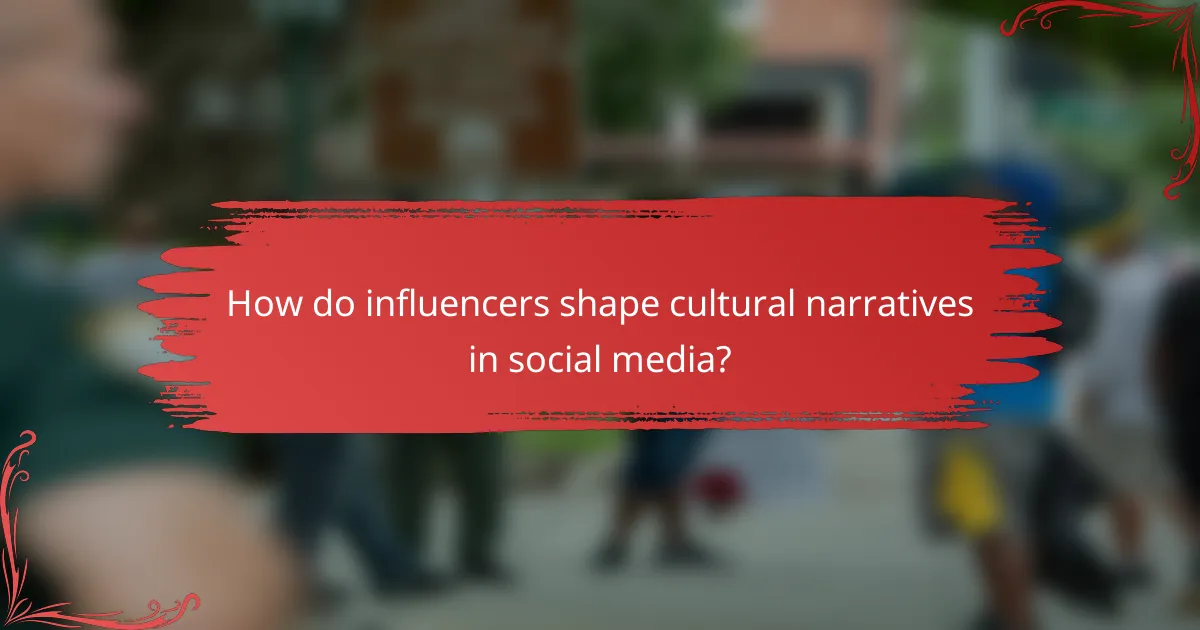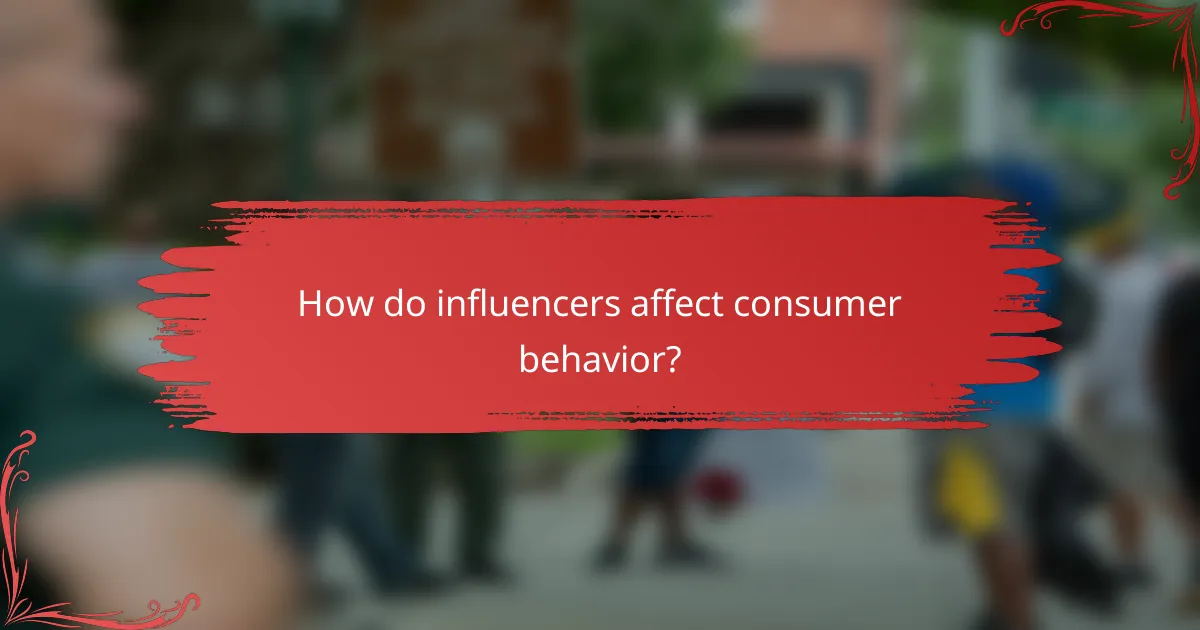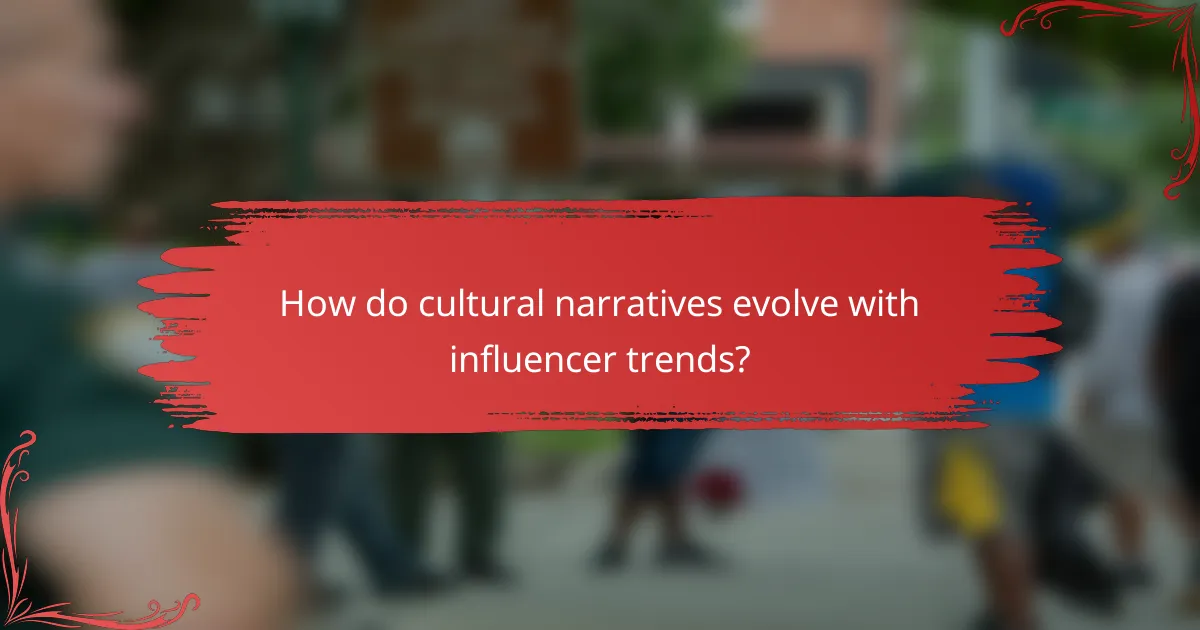Influencers play a pivotal role in shaping cultural narratives on social media, crafting relatable content that resonates deeply with their audiences. By sharing personal stories and promoting values, they influence trends and guide public perception, making them key figures in contemporary cultural conversations.

How do influencers shape cultural narratives in social media?
Influencers significantly shape cultural narratives on social media by creating relatable content that resonates with their audience. They leverage their platforms to share stories, promote values, and influence trends, ultimately guiding public perception and cultural conversations.
Influencer storytelling techniques
Influencers often use storytelling techniques such as personal anecdotes, visual storytelling, and emotional appeals to connect with their audience. By sharing authentic experiences, they create a sense of relatability that encourages followers to engage with their content. Techniques like behind-the-scenes glimpses or day-in-the-life videos further enhance this connection.
Additionally, influencers may employ narrative arcs that build suspense or highlight transformations, making their stories more compelling. This approach not only entertains but also fosters a deeper emotional investment from their audience.
Impact on audience perceptions
The narratives constructed by influencers can significantly alter audience perceptions of brands, lifestyles, and social issues. By endorsing products or causes, influencers can shift consumer attitudes and behaviors, often leading to increased brand loyalty or social awareness. Their opinions can carry more weight than traditional advertising, especially among younger demographics.
Moreover, influencers can challenge societal norms and promote inclusivity, thereby reshaping cultural standards. However, audiences may also develop unrealistic expectations based on the curated lives presented by influencers, which can lead to issues such as comparison and dissatisfaction.
Case studies of successful campaigns
One notable example is the #LikeAGirl campaign by Always, which utilized influencers to challenge gender stereotypes. Influencers shared personal stories and encouraged their followers to redefine what it means to do something “like a girl,” resulting in widespread engagement and a positive cultural shift.
Another successful campaign is the collaboration between fitness influencers and brands like Nike, which promoted body positivity and inclusivity. By showcasing diverse body types and fitness journeys, these influencers helped change perceptions around health and fitness, resonating with a broader audience.

What are the key platforms for influencer marketing?
The main platforms for influencer marketing include Instagram, TikTok, and YouTube. Each platform offers unique features that cater to different types of content and audience engagement, making them essential for brands aiming to leverage influencer partnerships.
Instagram’s visual storytelling
Instagram is renowned for its emphasis on visual content, making it ideal for influencers to showcase products through high-quality images and engaging stories. Brands can benefit from using Instagram’s features like Stories, Reels, and IGTV to create immersive experiences that resonate with followers.
When collaborating with influencers on Instagram, consider the aesthetic alignment between the influencer’s style and your brand. This ensures authenticity, which can significantly enhance audience trust and engagement.
TikTok’s viral trends
TikTok thrives on short, engaging videos that can quickly go viral, making it a powerful platform for influencer marketing. Brands can tap into trending challenges or memes to create relatable content that captures the attention of younger audiences.
To maximize impact, brands should encourage influencers to incorporate their products in a fun and organic way. This could involve challenges or creative storytelling that aligns with current trends, helping to boost visibility and engagement.
YouTube’s long-form content
YouTube allows for in-depth storytelling through long-form videos, making it suitable for detailed product reviews, tutorials, and lifestyle content. Influencers can provide comprehensive insights that help viewers make informed purchasing decisions.
When working with YouTube influencers, consider the importance of authenticity and thoroughness in their content. Collaborations should focus on genuine experiences and informative narratives, as these elements are crucial for building trust and encouraging viewer action.

How do influencers affect consumer behavior?
Influencers significantly shape consumer behavior by leveraging their reach and credibility to sway purchasing decisions. Their ability to connect with audiences on a personal level fosters a sense of trust that can lead to increased sales and brand loyalty.
Trust and authenticity
Trust and authenticity are crucial in influencer marketing. Consumers are more likely to purchase products endorsed by influencers they perceive as genuine and relatable. For instance, micro-influencers, who typically have smaller but highly engaged followings, often foster deeper connections with their audience, enhancing their perceived authenticity.
Brands should prioritize partnerships with influencers who align with their values and mission. This alignment helps ensure that endorsements come across as sincere rather than purely transactional, which can resonate more effectively with potential customers.
Social proof and engagement
Social proof plays a vital role in how influencers affect consumer behavior. When followers see their favorite influencers using a product, it creates a perception of popularity and desirability. This phenomenon often leads to increased engagement, as consumers are more likely to comment, share, or seek out products that influencers promote.
Brands can enhance their visibility by encouraging influencers to create engaging content, such as tutorials or unboxings. This interactive approach not only showcases the product but also invites followers to participate in discussions, further amplifying the brand’s reach.
Brand loyalty and advocacy
Influencers can cultivate brand loyalty and advocacy among their followers. When influencers consistently promote a brand, their audience may develop a stronger emotional connection, leading to repeat purchases and long-term loyalty. This loyalty can be particularly powerful when influencers share personal stories or experiences related to the brand.
To maximize brand advocacy, companies should consider establishing long-term partnerships with influencers. This strategy allows for deeper storytelling and a more authentic representation of the brand, ultimately fostering a community of loyal customers who advocate for the brand within their own networks.

What are the challenges faced by influencers?
Influencers encounter several challenges that can impact their effectiveness and sustainability in the digital landscape. Key issues include content saturation, maintaining authenticity, and navigating regulatory compliance.
Content saturation
Content saturation refers to the overwhelming amount of material available on social media platforms, making it difficult for influencers to stand out. With millions of posts shared daily, unique and engaging content is essential to capture audience attention.
To combat saturation, influencers should focus on niche markets or specific themes that resonate with their target audience. Creating high-quality, visually appealing content and leveraging storytelling can also help differentiate their brand.
Maintaining authenticity
Authenticity is crucial for influencers as audiences increasingly value genuine connections over polished marketing. Striking a balance between personal branding and authentic engagement can be challenging.
Influencers should share personal experiences and insights while remaining transparent about partnerships and sponsorships. Regularly interacting with followers and responding to comments can enhance perceived authenticity and build trust.
Regulatory compliance issues
Influencers must navigate various regulatory compliance issues, including advertising standards and disclosure requirements. In many regions, failing to disclose paid partnerships can lead to penalties and damage to credibility.
To ensure compliance, influencers should familiarize themselves with local regulations, such as the Federal Trade Commission (FTC) guidelines in the United States. Clearly labeling sponsored content and maintaining transparency with audiences are essential practices to avoid legal pitfalls.

What metrics measure influencer impact?
Influencer impact can be measured through various metrics that reflect engagement, reach, and conversions. These metrics provide insights into how effectively an influencer communicates with their audience and drives desired actions.
Engagement rates
Engagement rates indicate how actively an audience interacts with an influencer’s content. This metric is typically calculated by dividing the total interactions (likes, comments, shares) by the total followers, then multiplying by 100 to get a percentage. A higher engagement rate suggests that the content resonates well with the audience.
For example, an engagement rate of 3-5% is generally considered good for most social media platforms, while rates above 10% are exceptional. Influencers should aim to create authentic content that encourages audience participation to boost these rates.
Reach and impressions
Reach refers to the total number of unique users who see an influencer’s content, while impressions count the total number of times the content is displayed, regardless of whether it was clicked. Both metrics are crucial for understanding the potential audience size and visibility of posts.
For effective campaigns, influencers should monitor both metrics to gauge how far their content spreads. A strong reach combined with high impressions indicates that the content is not only being seen but is also engaging enough to prompt multiple views.
Conversion tracking
Conversion tracking measures the effectiveness of an influencer’s content in driving specific actions, such as purchases, sign-ups, or downloads. This metric is essential for brands looking to quantify the return on investment (ROI) from influencer partnerships.
To track conversions, influencers can use unique links, discount codes, or dedicated landing pages. For example, a conversion rate of 1-3% is typical for online campaigns, but this can vary significantly based on the niche and audience engagement. Brands should establish clear goals and use analytics tools to monitor these conversions effectively.

How do cultural narratives evolve with influencer trends?
Cultural narratives evolve alongside influencer trends through the continuous exchange of ideas and values on social media. Influencers shape perceptions by promoting specific lifestyles, beliefs, and products, which can lead to shifts in societal norms and expectations.
Influencer impact on societal values
Influencers play a significant role in shaping societal values by endorsing certain behaviors and lifestyles. For instance, when influencers advocate for sustainability, their followers may adopt eco-friendly practices, thereby altering community standards. This ripple effect can lead to broader acceptance of new values within society.
Shifts in consumer behavior
As influencers highlight particular products or brands, consumer behavior shifts accordingly. Followers often trust influencers more than traditional advertising, leading to increased sales for promoted items. This trend can create a cycle where brands tailor their offerings based on influencer feedback, further influencing cultural narratives.
Emergence of new cultural trends
Influencer trends can give rise to new cultural phenomena, such as viral challenges or fashion styles. These trends often spread rapidly across social media platforms, impacting various demographics. For example, a trending dance challenge can unite diverse groups, fostering a shared cultural experience.
Global vs. local narratives
While influencers can promote global narratives, they also have the power to highlight local cultures and issues. This duality allows for a blend of global trends with local traditions, creating unique cultural expressions. Influencers who focus on local content can help preserve cultural heritage while still engaging with broader trends.
Challenges and criticisms
Despite their influence, there are challenges and criticisms surrounding the role of influencers in shaping cultural narratives. Issues such as authenticity, the promotion of unrealistic standards, and the potential for misinformation can undermine their impact. It’s essential for both influencers and followers to critically evaluate the messages being shared to foster a healthier cultural dialogue.
